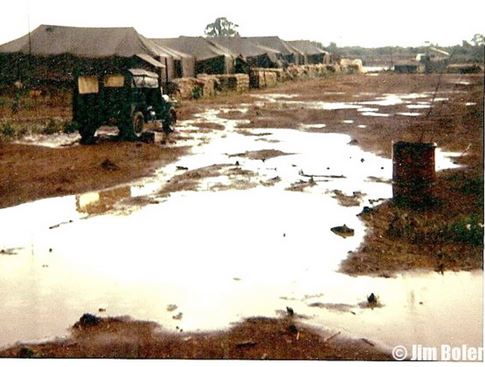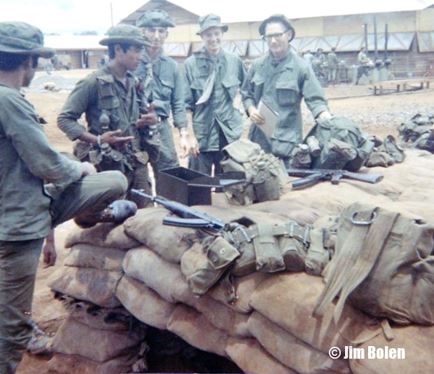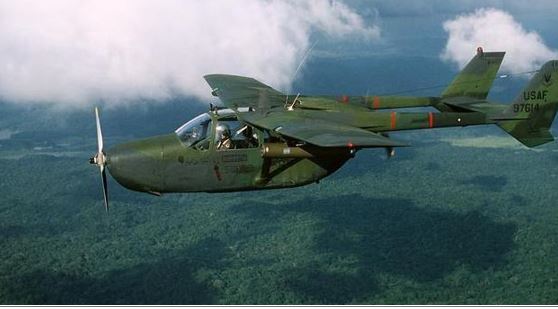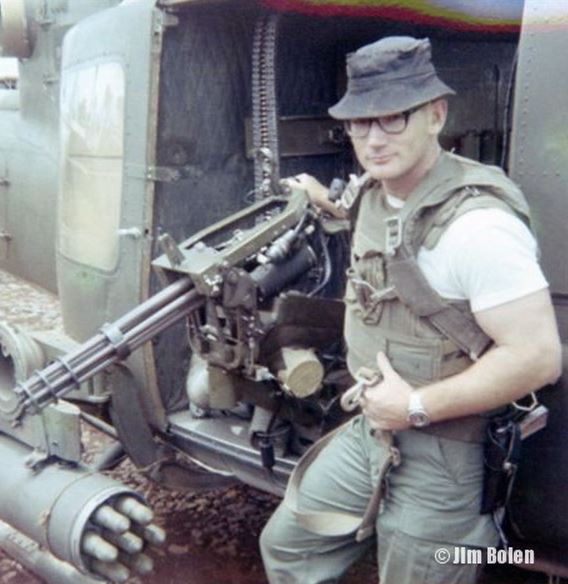The Jim Bolen SOG Interviews: Part 1 – Secret Missions Into Laos and Cambodia During The Vietnam War.
Jim Bolen is a former Special Forces operative, who went into Laos and Cambodia on dangerous and top secret SOG operations to the Ho Chi Minh and Sihanouk Trails during the Vietnam War. He was a recon team leader and went on over 40 SOG missions, being extracted under fire from over 30 of them.
A highly decorated soldier, Jim has also written a remarkable account of his life, before, during and after his time in Vietnam. Amazon: No Guts, No Glory.
Jim was interviewed by Peter Alan Lloyd.
PAL: Jim, what was life like living at Ban Me Thuot, South Vietnam, where you were based for much of your time in SOG?
I had no problem being at Ban Me Thuot living in tent city. I love camping so it was almost like a big camp out. There were 6 Americans living in each tent. We each had our little section of the tent divided as we liked. The latrines and showers were not the best but overall it was not bad. We were there in the tents during the rainy season so that was not the best. What does one expect, we are in a war zone.

This is tent city at Ban Ma Thuot, FOB 5, before they had their buildings built. It took them about 6 months.

When we first got to Ban Ma Thuot we lived in tents for a number of months with wooden floors built on 2×4’s. When we tore them down to move we found out why we did not have a rat problem, we had a friend living under us – a Boa.

Jim at ceremony when he was given one of his awards in 1968 at Ban Me Thuot, FOB 5, Vietnam.
PAL: Can you describe where in Laos and Cambodia you went on your SOG missions?
JB: Unfortunately I can’t be too precise because when I was given a mission the only part of the map I ever saw was of my area of responsibility. I never saw the whole map, just the small portion which was mine, so I have no idea if we were close to any small towns or villages.
We received daily intelligence reports up to the day of infiltration which would show enemy movement or bivouac sites along the Ho Chi Minh Trail in Laos or the Sihanouk Trail in Cambodia, if any, in that particular area. We usually had some idea of high speed jungle trails and sometime roads in the vicinity, and that was often the reason we were going in, to identify enemy movement, ease of movement and capabilities on these trails.
Other teams would get the adjoining areas and OP-35, SOG headquarters and the CIA would put this together like a puzzle to get an overall idea of what was going on. The CIA was looking for troop movement plus they wanted to know about vehicles, weapons being carried, condition of the enemy uniforms and attitude in general of the enemy, anything that would help us defeat the NVA.
A couple of my missions were into the Fish Hook area in Cambodia and a few into the tri-border region where the borders of Laos, Cambodia and Vietnam all meet, but most were in the central border area of Cambodia.
Soon after I got into country I was moved from FOB 2, Kontum which had responsibility for the tri-border area, to FOB 5 in Ban Me Thuot which worked the central part of Cambodia’s border area. Your FOB (forward operating base) is what determined the areas of responsibility.

This was late 1967 or early 1968 at Ban Me Thuot. I’d just got back from the range and was sitting on a bunker. The weapon I was holding was a M-3 Grease Gun with a integral silencer. Normally one member of
the recon team carried this weapon. It was a 45 caliber and was used as a RON (remain over night) gun (in case at night someone or something stumbles upon your position and you have to kill them or it without giving away your position) and also for prisoner snatches to get in and out without being compromised. The weapon was reliable but with the amount of ammo needed for a mission it was very heavy.
PAL: What made the Fish hook area of Cambodia so dangerous for SOG teams? (This is now the area thrusting into Vietnam between Memot and Snoul)
JB: From what I heard there were at least 2 NVA regiments strongly entrenched in that area with heavy anti aircraft weapons and they were very well organized. We had team members’ ankles getting grabbed by NVA, from disclosed (well-fortified and camouflaged) bunkers, as they were getting off the choppers. It was just not a very friendly area.
PAL: Can you describe what you would do the night before a mission?
JB: First, a few days before a mission I would stop showering and using deodorant. It is amazing how unnatural odors travel in the jungle. I would also wear and sleep in the uniform that I would be wearing in the field during this time. The night before a mission I would check my Montagnards to make sure they were prepared. After that I would go over infiltration procedures with my other American and make sure we were both on the same page. We’d check our equipment one last time, and then try to get some sleep, which was usually hard to do.
We were usually up early as we tried to insert as close to dawn as possible.

My team RT AUGER. First on the left is my point man Mang Koah, next my interpreter and good friend who was later killed while I was on extention leave, Nay Bunn. My assistants Sgt. Carle and Sgt Knowles, then me. We were just going over everything, getting ready to depart on a mission.
PAL: Did you have a favorite weapon that you took on every mission?
JB: Certain missions required that we carry specific weapons. Whenever we did have a choice I always chose the CAR-15. That, to me, is the finest weapon made. I think that I have killed people with every type of weapon that was available at that time and none were as good as the CAR-15.

Sgt Lewelling and me with CAR-15’s and XM-148 grenade launchers attached.
PAL: Did you take anything else with you on missions, other than weapons and food?
JB: While preparing to go on my first recon mission in Vietnam, early in the morning I was nervously sitting in the mess tent having breakfast. My gear was packed and we were departing in an hour.
I had a plastic spoon to eat my indigenous rice with in the field. I don’t like using plastic so I was looking at the spoon I was using. I stuck that spoon in my pocket; there were no US markings on it, and I took it with me on my first mission. I made it out alive and in my mind that spoon became my good luck item. I carried it on over 40 top secret missions out of Vietnam.

Jim’s Lucky Spoon, with SOG Patch
.
Later in my life, when I went to Africa, I carried it on every mission in the bush. Anything I did that had a certain amount of danger, I carried that spoon. I have never washed it in 46 years. I am looking at it now. I thought of having it melted down into a ring but I never have.
PAL: How long would the typical helicopter flight be to your LZ in Laos or Cambodia, from your base?
JB: That obviously depended on where we launched from. I would say flight times ranged from one to three hours.
Sometime we would spend the night at an American compound that was closer to the border area where we were going to be infiltrated. It was funny because they kept us secluded from the Americans and we weren’t allowed to have any contact with them. The Americans at the launch compound always wondered what the hell was going on.

U.S. Air Force helicopters insert special operations teams into Cambodia. Communist supplies moved from the port of Kompong Som, through Cambodia, to South Vietnam along the Sihanouk Trail. Until 1969, this artery, named after then-Cambodian leader Prince Sihanouk, was left largely untouched by US forces (USAF photo)
PAL: Why the need for secrecy from other Americans?
JB: At that time our government said we had no Americans on the ground in Cambodia or Laos. We did not want people writing home about what we were doing.
PAL: What kind of air support did you have when you went into Laos and Cambodia?
JB: Again we were supported by the 20th Air Force Squardron know as the “Green Hornets”. When we were inserted by chopper we were always escorted by four helicopter gunships flying cover, just in case the team was hit on insertion. There was always a FAC flying high above guiding the insert chopper to the LZ. The insert chopper would be flying at tree top level for their protection a ways from the LZ (the chopper flying at tree top would not allow the NVA to respond fast enough to fire on them if they were flying over unknown NVA compounds) that is why the FAC had to guide them. Many times I would be standing on the strut of the chopper at that time and have tree tops hitting my legs. The cover choppers were needed to protect the insert team in case of attack during infiltration. It is amazing the amount of fire power the cover choppers can put down. I can not begin to tell you how many times the Air Force gunships saved my butt.

We also had a Forward Air Controller, who flew a Cessna Skymaster which was a twin push pull engine aircraft, and he would guide us into the LZ.
The reason we had the helicopter gunships was because SOG teams were sometimes attacked on insertion, because the NVA knew the only way in for us was by using Landing Zones (LZ’s), coming in by chopper, so any good LZ was always watched if the NVA had the personnel.
PAL: Were you ever ambushed on insertion?
JB: With almost 50 missions I only remember one time that we were shot out of a LZ during insertion. We were fired on during the insertion before we were on the ground. It seemed to be only one NVA, probably a LZ watcher that got spooked. It was enough to cause us to abort the LZ and go to the secondary LZ.
PAL: How did you select your landing zones?
JB: The LZ was always picked out by the team leader, about a week or so before actual infiltration. This was done with the FAC during a flyover of the area with our map. We would have to fly high enough not to give any warning to the NVA of a possible insertion so some times the LZ up close during insertion was not nearly as good as we would have liked when we originally saw it a few thousand feet in the air through binoculars.
Once you had your primary LZ picked out you then looked for a secondary LZ in case the first one was compromised. The second LZ was on the other side of your area of responsibility, hopefully far away from the enemy you just encountered. The bad thing about having to use your second LZ was the NVA knew you were trying to get into their area and go on alert which made the mission much more dangerous.
PAL: Were the gunships ever needed?
JB: Not during infiltration for my team, luckily, but definitely on extraction. I came out 39 times under fire. Many times as I got on the chopper I would see the pilots taking rounds through their windshield. That is why I said in my book how brave these guys that supported us were. The men in the choppers were sitting ducks but they always came in to get us anyway. One of our worries were the NVA would use us for bait just to bring the choppers in so they could destroy as many as possible. The NVA knew that the choppers would keep coming in for us as long as we were alive.

0-2B Skymaster FAC plane

A Huey touches down at an LZ
We were supported by the 20th Special Operation Squadron, Green Hornets, Air Force, whose members lived with us on our FOB. We ate and drank together and that made for a close and bonding relationship. They knew personally every team member on the ground.

Tri-Border area and Central Cambodian border with Vietnam shown in red circles
Next Jim Bolen SOG Interview: Into the Jungle. What happened when the SOG teams were ‘safely’ on the ground, well behind enemy lines.
Jim’s book can be bought here: Amazon: No Guts, No Glory.


